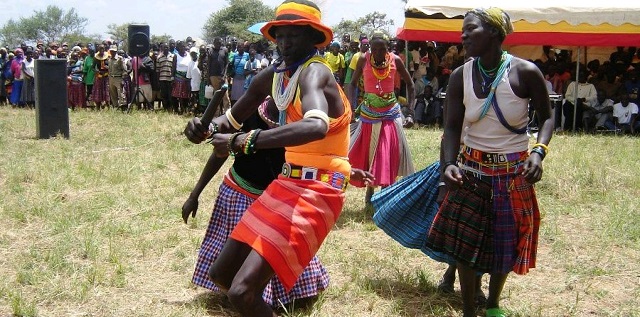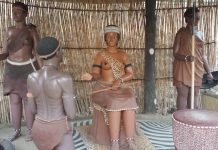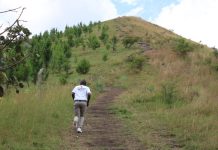The Karimojong ethnic group consists of several tribes including Dodoth, Taposa, Jie, and the Karimojong. Among other subdivisions of the tribe include the Pian, Matheniko, and Bokora. They’re considered as a single group called the Karamojong Cluster.
They live in the semiarid Karamoja sub-region of north eastern Uganda along the border with South Sudan and Kenya. The region consists of 7 districts which include Kaabong, Abim, Napal, Nakapiripirit, Moroto, Amudati, and Kotido. The tribes within the cluster share a common culture and language.
They’re predominantly semi-nomadic pastoralists who rely on livestock herding and slightly on seasonal crop cultivation as a source of livelihood. The Karamojong society is organized according to a patriarchal social system and has never had a king in history. The men, especially elders, hold authority over the family, clan, and community.
Land was communally owned given that livestock must be moved from one place to another according to the seasons of rain and drought. Cattle is especially a measure of wealth and raiding is an ancient practice deeply rooted into the socio-economic setup. Men with a high number of cows have a high status and power.
The elders would bless and encourage young men to take part in raids to gain status and respect. Raids would also be done to restock or redistribute wealth especially after severe epidemics like famine. During the colonial era, part of the land was used to create protected areas including Kidepo Valley national park and Pian Upe Wildlife Reserve. The Karimojong also obtained guns from the army barracks that was established in Moroto after Uganda’s independence.
Cattle raids became violent within the cluster and the Karimojong would often clash with the neighbors often involving human rights abuses, loss of livestock and lives. The political instability from the 1970s to 2000s caused disintegration among the Karimojong cluster. The Karamoja conflict somewhat led to the decline in the traditional customs of people and underdevelopment of the region due to little government interest.
The putting up of a culture leader is part of the long-term efforts to restore peace, unity, and strengthen culture among the Karamojong clusters. Government along with several NGOs intensified efforts to create opportunities and diversify beyond the cattle economy. Between 2010-2019, the region has seen infrastructure improvements, including roads, electricity, schools and health facilities, improved peace and security.
Investment opportunities in Karamoja continue to grow especially for cultural tourism development, mining, and education. The cultural leaders within the Karamoja cluster came together and formed the Karamoja Cultural Association (KCA) in 2014. The institution’s symbol of unity is a cow. It is recognized under the laws of Uganda and includes an annual cultural event and a central council of elders represented at each of the seven districts.
KCA philosophy is all-inclusive and allows women, youth, and children, who have historically been excluded due to the social structure, to participate. KCA exists to confront the complex challenges faced by the Karamojong by finding better ways to redress the ills of the past that have bred mistrust and division within the cluster. The Elders Council from the districts across the region recently elected their cultural leader for the first time in history.
The first Karamoja Cultural leader known as Papaa Angasuban Peter Adei is 81-years-old from Abim district. He is responsible for uniting people and advocating for innovative strategies that will foster development and address the most pressing challenges. For instance, the KCA strives to create a good reputation which is essential to attaining peace and security in the communities.
Given that the Karamojong elders have always been accused of aiding and abetting criminals that they bless their sons to raid cattle and dominate the weaker tribes. KCA is also putting emphasis on strengthening culture and heritage through the annual Karamoja Cultural Event (KCE) which brings together people in the Karamojong cluster with those from the neighboring countries.
The cultural event is held every year on a rotational basis across the seven districts that make up Karamoja. Given that the tribes within the cluster share a lot in common, the aim is to address the problem of disunity and achieve solidarity. The 2023 Karamoja Cultural Event under the theme ‘Celebrating Diversity, Resilience and Peace Building’ was held in Napak district at St. Daniel Comboni Senior Secondary School.
The Karimojong have been keen at preserving their unique ancient customs. However, the Uganda government has always encouraged them to move away from their traditional semi nomadism and adapt to the modern ways of living. KCE is therefore a platform to advocate for their cultural identity.
The Karimojong have rich cultural heritage including traditional high jump dance performance, the colorful beads and dress attire, facial scarifications, and African rock art. Some of the tribes have maintained their traditional housing systems known as Karimojong Manyattas. For instance, Nakapelimoru in Kotido district which is home to the Jie people is one of the last surviving African traditional villages.
Locals have been encouraged to embrace tourism development by welcoming visitors to their homes. Tourism provides an alternative source of income through selling arts and crafts and getting involved in guiding, hospitality, and conservation. Culture capitalizes on the rich biodiversity and beautiful landscape in Kidepo valley national park and Pian Upe Wildlife Reserve. The KCA leadership initiative will be integrated into tourism, security among other aspects of development.













